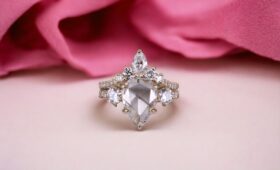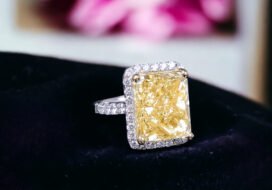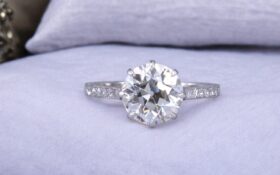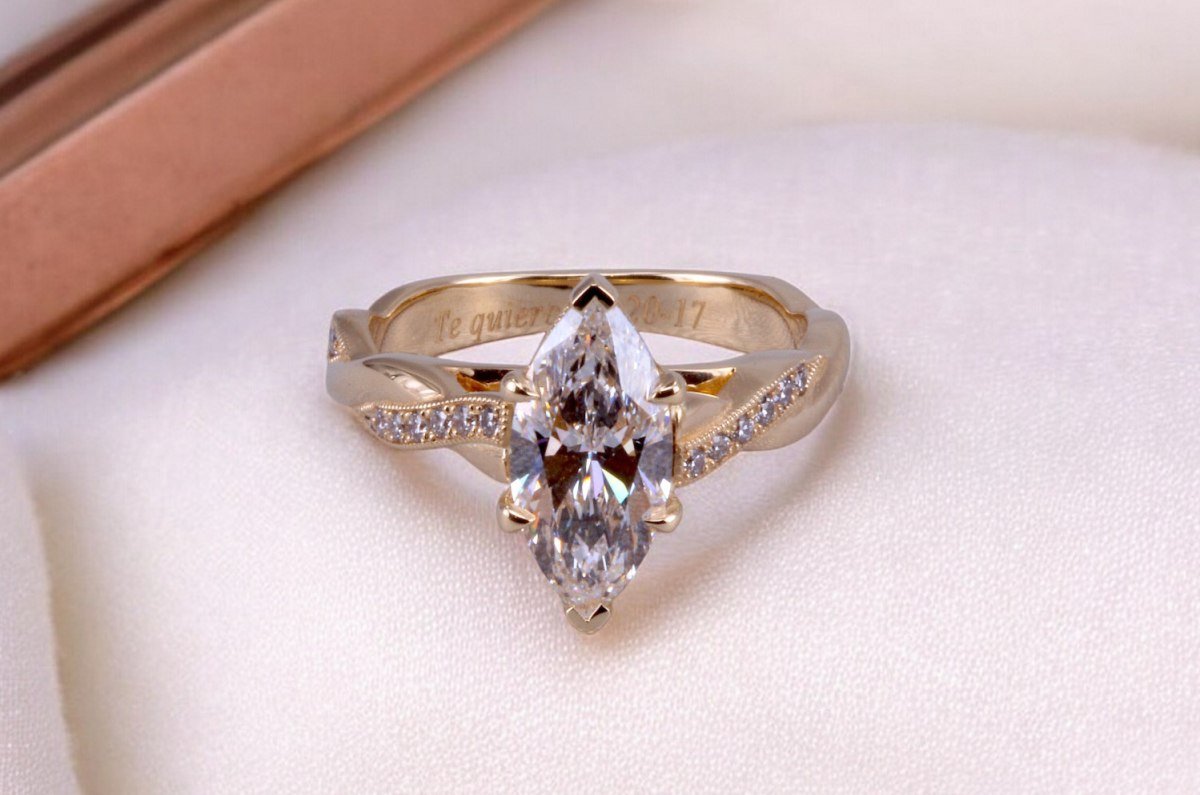
11 Apr The History & Style of Pavé Set Diamond Rings
Designed by Carl Blackburn, the custom-made Marquis diamond engagement ring above features pavé set diamonds in the intertwined band.
Pavé set diamond rings epitomize the perfect blend of history, style, and elegance, captivating lovers of fine jewelry for centuries. This exquisite setting is one that La Jolla jewelry designer Carl Blackburn often incorporates into his custom engagement ring designs, as it creates a shimmering display of brilliance. The allure of pavé set rings also lies in its versatility. In the hands of a skilled custom jeweler, this setting can effortlessly transition from timeless classics to modern, innovative ring designs.
The Historical Significance of the Pavé Setting
The pavé setting dates back to the 18th century, a time of artistic and cultural innovation. Derived from the French word pavé, meaning “paved,” the term reflects the setting’s distinctive surface of closely set diamonds that resemble a cobblestone street. This style flourished during the Georgian and Victorian eras, when fine detail and decorative elegance were highly prized. Jewelers used the pavé technique to enhance their creations with added sparkle and refined craftsmanship.
The late 19th and early 20th centuries brought a resurgence of the pavé setting during the Art Nouveau and Art Deco movements. These periods celebrated flowing lines, symmetry, and the interplay of light — qualities beautifully highlighted by pavé’s radiant finish. This technique enabled jewelers to explore innovative forms while maintaining visual delicacy and brilliance.
Over the 20th century, the pavé setting evolved alongside shifting tastes. From the bold glamour of the Roaring Twenties to the minimalist lines of mid-century modern design, pavé proved its versatility. It suited both extravagant and understated styles, making it a favorite among fine jewelry lovers. Today, pavé continues to shine in engagement rings, wedding bands, and bespoke fine jewelry in San Diego.
An 1800s Losenge Ring Featuring Pavé Set Old Mine Cut Diamonds
Understanding the Pavé Setting Technique
The pavé setting is a meticulous process that demands expert skill. Tiny diamonds — often called melee stones — are set into small holes drilled into the metal surface. Each stone is secured by tiny prongs or beads of metal pushed gently over the edges. The result is a continuous, glittering surface that maximizes light reflection and gives the illusion of a seamless field of diamonds.
One of the pavé setting’s strengths lies in its ability to enhance a design without overpowering the central stone. The fine shimmer of the melee stones serves as an elegant backdrop, making a larger center diamond appear even more brilliant. This makes pavé bands especially popular in engagement ring designs.
Beyond aesthetics, the pavé setting offers practical advantages. The closely packed diamonds are well supported by the metal framework, reducing the risk of stones falling out. However, due to the delicate nature of the prongs and the number of stones involved, routine inspection and maintenance are recommended to preserve the ring’s integrity and shine.
Different Styles of Pavé Set Diamond Rings
Pavé set diamond rings come in a range of styles, each offering unique charm and character. A classic pavé band features diamonds set along the entire length of the band, creating a constant shimmer from every angle. This style works beautifully with a solitaire center stone or as a standalone band.
The halo setting is another popular option, where a circle of pavé diamonds surrounds a central stone. This design amplifies the appearance of the center diamond, making it look larger and more radiant. Some variations feature a double halo for added depth and sparkle.
For those drawn to vintage-inspired jewelry, pavé rings with milgrain edging, filigree, and intricate patterns evoke the romance of past eras. These designs often channel the elegance of the Art Deco and Edwardian periods, blending old-world detail with modern craftsmanship. Whether you favor clean lines or ornate flourishes, C. Blackburn Jewelers can create a pavé ring style to match every preference.
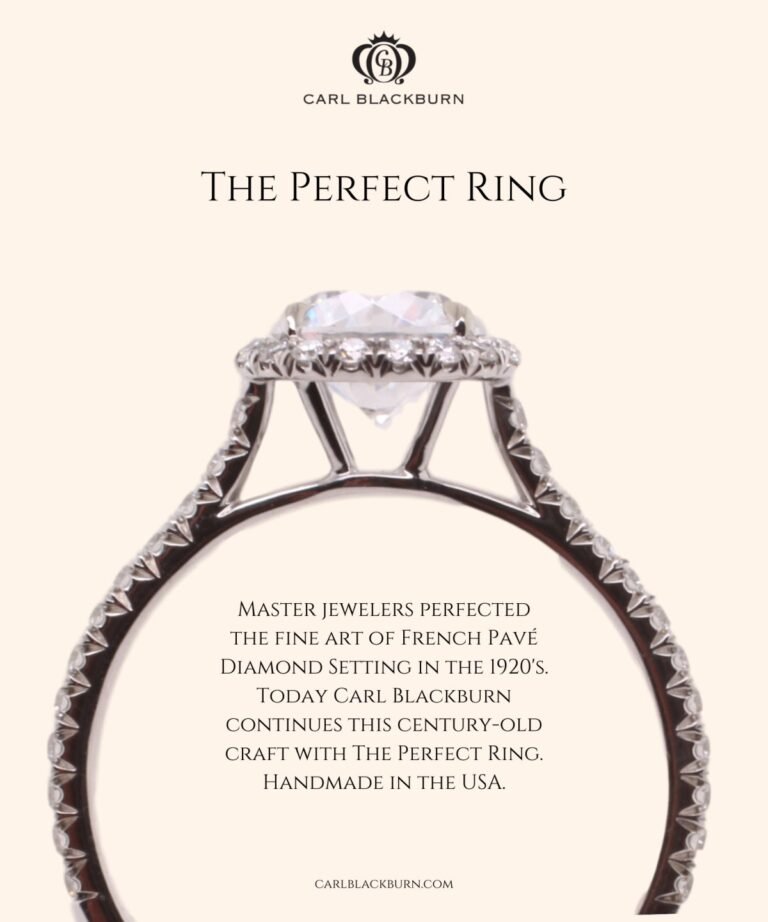
Comparing Standard Pavé and French Pavé Settings
While the pavé setting is celebrated for its delicate shimmer and timeless elegance, a more refined variation — known as the French pavé setting — offers a unique level of craftsmanship and brilliance. Also referred to as the French cut or fishtail setting, this technique elevates the traditional pavé look through more precise and detailed metalwork.
In a standard pavé setting, small diamonds are placed closely together and secured with tiny metal prongs or beads. This creates a smooth, glittering surface where the diamonds appear to float along the band. The metal is largely unobtrusive, allowing the light to dance across the stones with minimal distraction. It is a beautiful and versatile technique used in a wide range of jewelry styles.
The French pavé setting, by contrast, involves carving V-shaped grooves into the metal between each diamond. This careful hand-cutting process not only secures the stones but also allows more of the diamond’s surface to remain visible, especially from the sides. The result is a more sculptural and symmetrical appearance, with sharply defined angles and increased sparkle. French pavé is known for its visual depth and light play, which give the ring a crisp, architectural elegance.
True French pavé requires an extraordinary level of skill, and the artisans at C. Blackburn Jewelers are among the few local craftspeople who have mastered it. Unlike machine-made or mass-produced settings, this method relies on the steady hand and trained eye of an expert jeweler.
Every groove must be meticulously aligned, and every diamond must be placed with precision to achieve the perfect balance of symmetry and brilliance. This is one of the reasons why renowned jewelry houses such as Cartier, Tiffany & Co., and Harry Winston often feature French pavé in their most iconic designs — it exudes refinement and attention to detail that few other settings can match.
In addition to its beauty, the French pavé setting also offers functional advantages. The diamonds are often set slightly lower into the band, providing better protection from chipping or damage. The inward-curving prongs are less likely to catch on fabric, making the ring more practical for daily wear. And because the setting typically incorporates more structural metal along the sides, the ring is less prone to bending over time. For those seeking both elegance and durability, French pavé presents a compelling alternative to traditional pavé styles.
Choosing between standard and French pavé comes down to personal style and appreciation for craftsmanship. While both offer exquisite sparkle and timeless charm, French pavé appeals to those who value precision, symmetry, and a more defined aesthetic. It’s a setting that showcases not only the brilliance of the diamonds but also the artistry of the California jeweler who creates it.

Comparing Pavé with Other Diamond Setting Techniques
While the pavé setting is renowned for its elegance, it’s helpful to understand how it compares to other diamond settings. Each has its own strengths and visual effects.
The prong setting, for instance, uses metal prongs to hold the diamond, allowing more light to pass through the stone. This is a classic choice for solitaire engagement rings due to its ability to enhance brilliance.
In contrast, the bezel setting encircles the stone with a thin metal rim. This provides excellent protection, making it ideal for active lifestyles. While it may slightly reduce sparkle compared to pavé or prong settings, it offers a sleek, modern look.
Another option is the channel setting, where diamonds are set between two metal strips in a continuous row. This style, often used in wedding or eternity bands, strikes a balance between the sparkle of pavé and the security of bezel settings. Ultimately, choosing a setting comes down to personal style, desired aesthetics, and how the piece will be worn.
The Elegance of Pavé in Modern Jewelry
In contemporary jewelry, pavé settings remain a popular choice for their elegance and adaptability. Modern San Diego jewelers like C. Blackburn Jewelers in La Jolla use the technique in creative ways, crafting pieces that range from delicate and minimal to bold and avant-garde.
One of the reasons pavé remains in demand is its ability to complement other gemstones. Though most often used with diamonds, pavé can incorporate sapphires, rubies, emeralds, or colored diamonds to create vibrant, customized designs. This flexibility in color and form makes pavé ideal for both traditional and cutting-edge looks.
Durability is another reason for its popularity. Well-crafted pavé rings are secure enough for daily wear, and their timeless beauty ensures they won’t go out of style. Whether worn as a personal keepsake or passed down as an heirloom, pavé set rings offer lasting elegance.

Choosing the Right Pavé Set Ring for Your Style
When selecting a pavé set ring, consider your personal style, lifestyle, and budget. Pavé rings are available in various metals, including platinum, white gold, yellow gold, and rose gold. Platinum and white gold lend a cool, modern tone, while yellow and rose gold bring warmth and vintage appeal.
Design is another key factor. Classic pavé bands suit minimalist tastes, while halo or vintage styles may appeal to those who love extra sparkle or historical motifs. Think about what fits your everyday look and what feels meaningful to you.
Diamond quality also matters, even for the smaller melee stones. While they’re less costly than large center diamonds, high color, clarity, and cut still affect the overall brilliance of the ring.
When you work with C. Blackburn Jewelrs in La Jolla, you can be assured of receiving well-matched, high-quality stones that enhance the ring’s appearance and perfectly complement the design.
Contact Carl Blackburn directly by calling 858-251-3006 or send him a text message at 619-723-8589. You can also use the contact form below to send an email.


